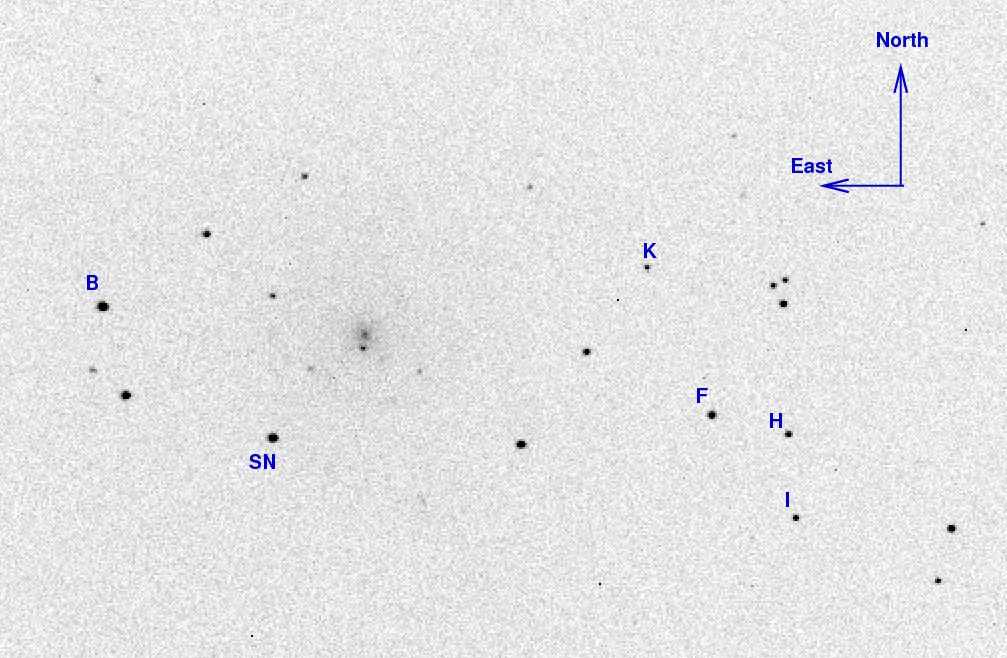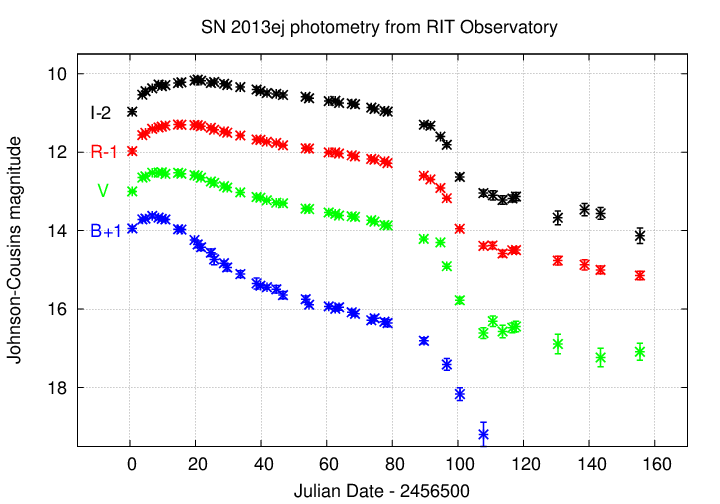
On the night of Dec 28/29, 2013, I observed SN 2013ej in M74, for what would turn out to be the last time (sniff, sob). Conditions were fair: clear at the start of the night, but some small changes in transparency (+/- 0.2 mag) during the observations.
The main setup was:
Notes from the night
SN 2013ej is a Type II supernova in the relatively nearby galaxy M74. It was discovered by the KAIT group about one week before maximum light. Here's a chart showing the galaxy, the SN, and some reference stars:

The reference stars marked above have magnitudes in AAVSO chart 12459CA, as follows:
letter B sigB V sigV R sigR I sigI B 13.012 0.019 12.510 0.019 12.154 0.019 11.834 0.019 F 13.848 0.026 13.065 0.022 12.622 0.025 12.152 0.027 H 14.338 0.029 13.692 0.024 13.329 0.029 12.964 0.030 I 14.832 0.027 13.912 0.023 13.416 0.026 12.939 0.030 K 15.192 0.034 14.613 0.027 14.275 0.034 13.915 0.036
I took 30-second guided images in VRI, though the guide star was occasionally lost. After discarding the bad images, I was left with 24, 23, and 28 images in V, R, and I, respectively.
I re-centered the field after taking 6 good images, which left the southernmost portion of the image somewhat underexposured compared to the rest. That underexposed region does not come close to the SN, but it does almost touch star I, one of the reference stars.
Using aperture photometry with a radius of 4 pixels (radius of 7.4 arcsec), I measured the instrumental magnitudes of a number of reference stars and the target. Following the procedures outlined by Kent Honeycutt's article on inhomogeneous ensemble photometry, I used all stars available in each image to define a reference frame, and measured each star against this frame. I used the AAVSO magnitudes, plus color terms to convert the ensemble instrumental magnitudes to the standard Johnson-Cousins BVRI scale.
The SN is now so faint that I've stopped making measurements in B. I coadded (using a median technique) all the good images in each filter to create a single image with higher signal-to-noise. I now measure the SN in co-added images only. Below is a comparison of the results derived from individual images to those derived from the median image:
median - individual B V R I ------------------------------------------------------------------------- Sep 11 UT -0.098 -0.016 -0.003 -0.002 Sep 18 UT 0.059 -0.005 0.009 -0.013 Sep 19 UT -0.078 0.015 -0.007 0.003 Sep 25 UT 0.019 0.006 0.009 0.006 Sep 27 UT 0.073 -0.022 -0.005 -0.015 Sep 29 UT -0.015 0.019 0.010 0.015 Oct 02 UT 0.026 -0.006 -0.002 -0.020 Oct 03 UT 0.015 -0.018 0.005 0.002 Oct 08 UT -0.004 0.004 0.002 0.004 Oct 09 UT 0.001 0.011 -0.002 -0.011 Oct 12 UT 0.005 0.007 -0.004 0.014 Oct 13 UT 0.054 0.016 -0.003 -0.003 Oct 24 UT 0.056 -0.008 -0.010 0.027 Oct 29 UT -0.016 -0.013 -0.021 Nov 03 UT -0.024 0.019 0.005 Nov 11 UT +0.154 0.009 0.020 Nov 20 UT 0.090 -0.012 0.028 Nov 21 UT 0.041 0.085 -------------------------------------------------------------------------
I will report the results based on the median images below.
Results from this evening are:
filter mag mag_uncert Julian Date V = 17.089 +/- 0.217 (ens 0.216 zp 0.021) 2456655.49267 R = 16.144 +/- 0.109 (ens 0.109 zp 0.009) 2456655.47490 I = 16.132 +/- 0.196 (ens 0.195 zp 0.019) 2456655.51409
The uncertainties here are dominated by extracting the instrumental magnitudes.
Grab the text file below for all the RIT measurements of SN 2013ej. All these values have been recomputed with the new color terms of UT 2013 Aug 05.
The final stage of the light curve is noisy, but it appears consistent with an exponential decay (which looks like a straight line in this magnitude-versus-time diagram).

Last modified 1/16/2014 by MWR.